Books, movies, games, and science fiction television shows, along with various other media, have long been the “home” of numerous impressive technologies.
Many of these ideas have inspired scientists today, but have you ever wondered how close they are to becoming reality? In this article, let’s explore the 10 most notable science fiction technologies and assess their likelihood of appearing in real life within the next 30 years.
1. Holodeck (Star Trek)
Likelihood of becoming reality in the next 30 years: 0%
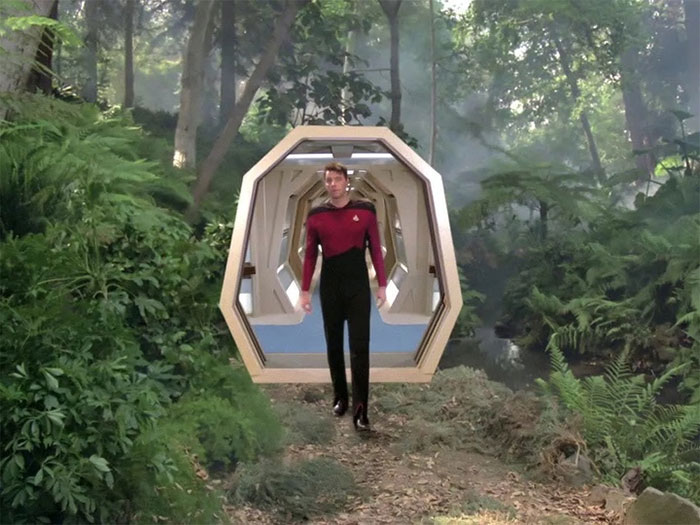
Virtual reality experiences have been prevalent in science fiction, but few examples are as iconic or intriguing as the Holodeck from Star Trek.
While Star Trek fans might immediately think of the episode “The Next Generation” when Holodeck is mentioned, the origins of this technology can be traced back to author Ray Bradbury (famous for the science fiction novel Fahrenheit 451), who wrote about a virtual reality room in his 1950 story “The Veldt” that could recreate anything a human could imagine. However, the concept may have first been proposed by Alexander Mokowski, a 19th-century German writer.
The Holodeck first appeared in Star Trek in 1974 in the episode “The Practical Joker” from Star Trek: The Animated Series, long before it became a vital part of Star Trek: The Next Generation and the subsequent Star Trek works.
Sadly, a Star Trek-style Holodeck is still quite a distant dream. Advances in VR, AR, and holographic projection continue to emerge, but clearly, we are not close to filling a room with solid projections of humanoid AIs. Perhaps we will have to wait until the 24th century to enjoy virtual dates with our favorite Star Trek characters!
2. KITT (Knight Rider)
Likelihood of becoming reality in the next 30 years: 50% (some technologies are already available)
Knight Rider introduced audiences to the 1982 Pontiac Trans-Am, modified with the Knight Industries Two Thousand (KITT) package, featuring a host of exciting functionalities, the most notable being its human-like AI.
Since the 1980s, artificial intelligence has made significant strides. With technologies like Google Duplex, we are getting closer to an AI that can deceive people into believing they are conversing with another living human rather than a complex code block.
What about KITT’s other technologies? Self-driving cars: they have become a reality, capable of traveling hundreds of miles with little to no driver intervention—Tesla even developed a “summon” feature to call the car to a desired location years ago. Acceleration from 0-100 km/h in 2 seconds: the Dodge Challenger SRT Demon can achieve something quite similar, just slightly slower. Screens, touch panels, integrated AR technology: most cars today have the first two, while a few luxury vehicles boast all three; we even have models with windows that can change color!
However, not all of KITT’s technologies have come to fruition. The pull-out chemical analysis tray and the Passive Laser Restraint System are two features that remain quite far off.
3. Cortical Stack (Altered Carbon)
Likelihood of becoming reality in the next 30 years: 0%
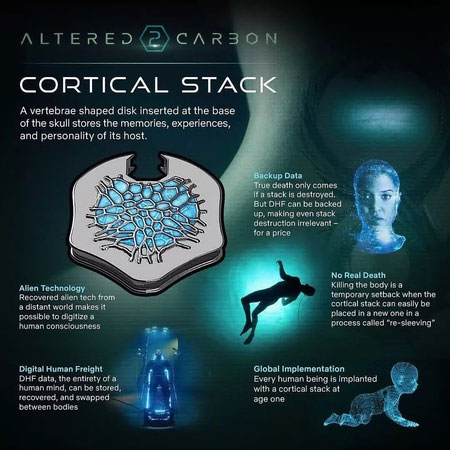
Season 2 of Altered Carbon did not match the quality of Season 1, but Netflix deserves criticism for canceling this promising series. Altered Carbon is famous for its array of cutting-edge technologies, from synthetic humans and AI to guns capable of reloading spent cartridges. However, the standout feature of the series, and the centerpiece of the plot, is the cortical stack.
If you are not familiar, the cortical stack is a disc-shaped device that can store human consciousness, allowing individuals to transfer their souls into new bodies called sleeves. Those wealthy enough to purchase a new sleeve can essentially achieve immortality, able to resleeve whenever their current body is no longer viable; meanwhile, those less fortunate will have their cortical stacks stored upon death. A person can exist indefinitely as long as the stack remains intact—however, one can have multiple backup copies of the stack to revive in case one is destroyed.
Aside from the ethical and legal issues this technology could raise, the ability to transfer human consciousness to artificial bodies remains firmly in the realm of science fiction. In 2015, a startup claimed they could make this a reality within 30 years, but since then, we have not heard any further updates. Nevertheless, imagine how incredible it would be: if your body succumbs to an incurable disease, you could simply jump into a new one!
4. JARVIS (Marvel Universe)
Likelihood of becoming reality in the next 30 years: 60%
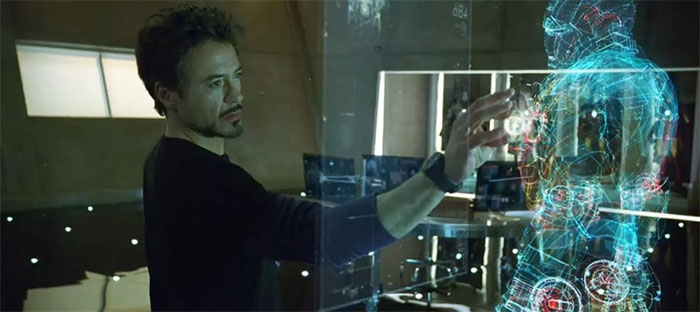
“Just A Rather Very Intelligent System”, abbreviated as JARVIS, is an extremely advanced artificial intelligence system. This AI is essentially more sophisticated, intelligent, and human-like than KITT mentioned earlier.
Real-world AI systems are becoming increasingly reminiscent of those in films, capable of deceiving humans into believing they are conversing with a real person while performing tasks that we could not have imagined 20 years ago. And while smart voice assistants have not yet reached the level of JARVIS, they are already much more practical. Will we one day look back and realize that Alexa was the precursor to an AI similar to Tony Stark’s?
A real-life JARVIS would undoubtedly be something extraordinary, but remember Elon Musk’s warning that uncontrolled advancements in AI pose the “greatest threat to humanity’s existence” and “are more dangerous than nuclear bombs.”
JARVIS also helped create the Iron Man Mark II suit, demonstrating that AI can be used as a weapon. Killer robots have become a particularly hot topic in recent years, as more countries seek to develop automated weapons capable of identifying and targeting predetermined objectives without human intervention. Let’s hope we don’t inadvertently create an Ultron!
5. Handheld Terminal (The Expanse)
Likelihood of becoming reality in the next 30 years: 95%
The Expanse is another science fiction series filled with “cool” technologies, one of which is something that may soon become a reality: handheld terminals. These devices might look like phones from the future, but Ty Franck, co-author of the novels and producer of the TV series, pointed out some important differences.
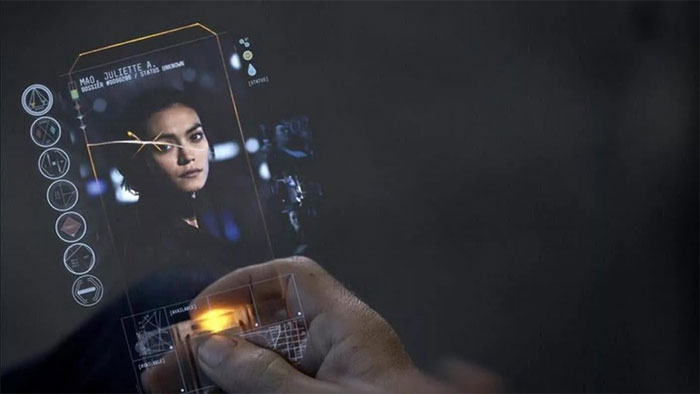
Although both serve similar functions, handheld terminals are not high-performance handheld computers but rather smart screens with limited processing power and integrated memory. They will wirelessly connect to surrounding smart devices and local computer networks to perform heavy tasks.
Handheld terminals operate based on a unified data protocol, allowing them to connect to local networks whether they are in space, underground, or anywhere else. They have the capability to recognize users and provide information based on their environment and needs.
We have seen transparent OLED screens in various sliding glass doors and a concept TV, so this technology is likely on its way to becoming a reality. Handheld terminals can also recognize hand gestures—similar to many current smartphones—allowing them to send information to others or to a TV. Mirroring a phone’s screen onto a TV is relatively easy today, though the process is not as smooth as with handheld terminals. They also come in various sizes, just like smartphones and iPads.
While a complete handheld terminal has yet to emerge, we can be certain that Expanse-style devices or something similar will become a reality in the next 30 years, possibly even sooner.
6. Flying Cars (from Back to the Future, The Jetsons, Futurama…)
Likelihood of becoming a reality in the next 30 years: 70%

You might say that flying cars already exist, but it’s important to note that most of them are small vehicles, not much different from cars that can drive on roads or simply large drones capable of carrying people. What we want is a flying car like in Back to the Future—essentially, a vehicle that looks like a car but can fly like an airplane.
One of the most operational prototypes resembling a true flying car comes from a Slovak company called Klein Vision. Their AirCar Generation 5 might make many people mistake it for an ordinary two-seater sports car, but with the push of a button, it will “grow” a tail and wings. As long as there is a clear stretch of road about 300 meters ahead, the AirCar can take off and lift you into the air.
According to the Boston Consulting Group (BCG), in the worst-case scenario, we will “only” see around 10,000 flying cars, including drone-like vehicles, in the skies by 2030. However, if everything goes according to plan, the company estimates that there could be as many as 60 million flying cars on the market, with a total number of flights reaching… 825 billion. The company also believes that urban flying taxis will become “commonplace” by 2040. Just hang on for a few more decades!
7. Teleportation Devices (from Star Trek)
Likelihood of becoming a reality in the next 30 years: 0%
A teleportation device like in Star Trek, if it were real, would create world-altering impacts. Imagine being able to jump anywhere on Earth, or even beyond the confines of this planet, in the blink of an eye. It would also have enormous applications in industries like automotive, aviation, and oil, but hold on: such a technology is extremely unlikely to ever become a reality.
According to Star Trek, a teleportation device would “disassemble” a person into a “stream of discrete matter at the subatomic level” by breaking the bonds between atoms, then transmit them to a buffer with information about the original before sending them to the destination. The stream of matter would be reassembled into the person upon arrival, with atoms put together in the original order via a device known as the “Heisenberg compensator.”
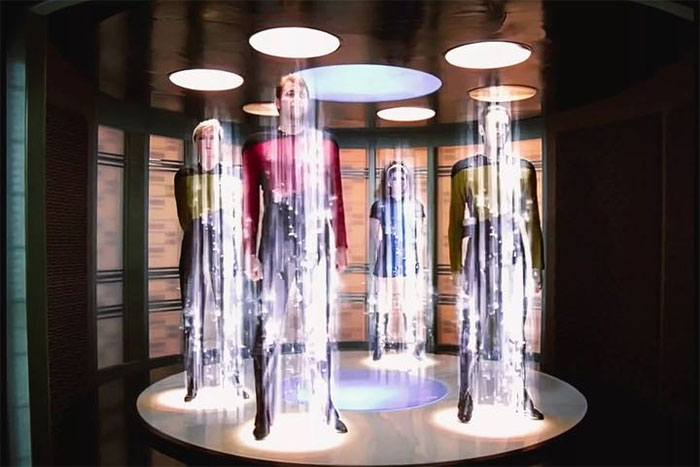
Essentially, instead of teleporting a person from one place to another, the teleportation device would… kill the user before creating identical copies of them at the destination. If such technology existed, it’s hard to imagine anyone daring to step inside, no matter how convenient it might be.
Last year, we saw a quantum teleportation device transmit over 10 miles in open space, although it is very different from the teleportation depicted in science fiction. While teleportation involves linking two particles so their states depend on each other, each particle can be affected by the state of the other. This entanglement means that changing the state of one particle will cause the other to change as well, allowing for the instantaneous transfer of quantum information. Quite amazing, but don’t expect humans to be teleported like that in real life!
8. Implantable Guns Inside Arms/Hands (from Upgrade)
Likelihood of becoming a reality in the next 30 years: 40%
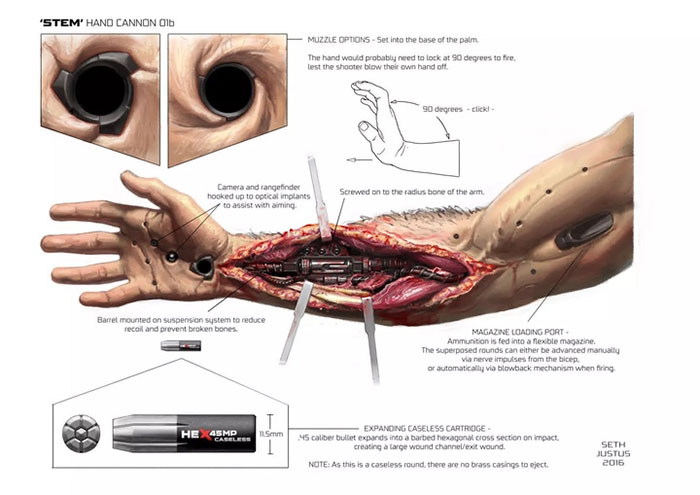
The horror/thriller film Upgrade features a plethora of imaginative technologies, from super-intelligent AI to nanobots that can kill with a single sneeze. But one of the coolest and most talked-about items in the film is the gun that the antagonists implant in their arms/hands, capable of firing by moving their hand at a 90-degree angle.
Implantable weapons also appear in the game Cyberpunk 2077, but in Upgrade, they seem more realistic: the ammunition is loaded into a port located within the muscle; there is a camera and sight in the palm to transmit data to the optical implant for aiming; and this device even includes shock-absorbing systems to prevent bones from shattering when fired, which is quite inconvenient.
Last year, the world’s first smart gun activated by an implant appeared, although it wasn’t very high-tech. It uses RFID to ensure that only those with compatible implants can fire it. Could this be the precursor to a complete implantable gun?
In addition to technological barriers such as overheating, infection, and the risk of causing the entire arm to explode, there are numerous ethical and legal issues surrounding this type of weapon. And with many small holes and cameras attached all over the hand, how can you hide your weapon? Ultimately, you may face the risk of accidentally blowing your brains out when you raise your hand to…pick your nose!
9. Time Travel (films like Dr. Who, Back to the Future, Looper…)
Likelihood of becoming a reality in the next 30 years: 0%
Who wouldn’t want the chance to turn back time? Whether for personal reasons or for humanity, the idea of traveling back to the past has always been an endless source of inspiration for people over the decades. But is that ever going to be feasible?

While there have been many studies on using quantum mechanics principles to travel vast distances without aging (relative time travel), don’t expect to see that in the near future.
Traveling back and forth in time is a different story. Many theories have emerged in recent years asserting that this is impossible, no matter how advanced our technology becomes, and a new study conducted last year came to a similar conclusion.
Like everything in life, there will be many who will fiercely debate this clear evidence. Perhaps the reason we have never discovered time travelers is that they have disguised themselves too well; maybe time travel will be feasible in certain areas of space; for instance, near black holes, if they truly exist. Regardless, we certainly will not be able to time travel in the next 30 years.
10. Invisibility Cloak (film Predator)
Likelihood of becoming a reality in the next 30 years: 100%
The invisibility cloak we are referring to here is similar to the technology used by Predators in the films of the same name, capable of bending light, rather than the magical cloak of Harry Potter. The application of an invisibility cloak would undoubtedly completely change the landscape of warfare—where soldiers could hide from enemies and even conceal vehicles or buildings from enemy aircraft. Although films depict this amazing technology as a product of advanced alien species, in reality, it is very close to becoming a reality right here on Earth.
Instead of the impractical and inaccurate method of using a camera to film objects behind an item and projecting it onto the surface (similar to the infiltration scene in Mission Impossible – Ghost Protocol), we now have types of invisibility cloaks that function just like the Predators’ cloak.
This technology uses metamaterials, which are synthetic dielectric metals engineered at the nanoscale. According to Interesting Engineering, “the synthetic structure acts like an artificial array of atoms, allowing electromagnetic radiation to comfortably navigate around an object. The metamaterial will redirect light around the object it is covering to create the visual effect that the object is not there.”
The Canadian company HyperStealth Biotechnology Corp gained attention in 2019 when it demonstrated a prototype of a camouflage material designed for military use. It can not only conceal objects from the naked eye but also shield them from infrared and ultraviolet imaging devices.
Of course, there are still many issues to resolve; current prototypes cannot make an object completely invisible. But don’t be surprised if they become a standard part of soldiers’ gear by 2051.
What are your favorite sci-fi technologies that you hope to see in the next 30 years?




















































